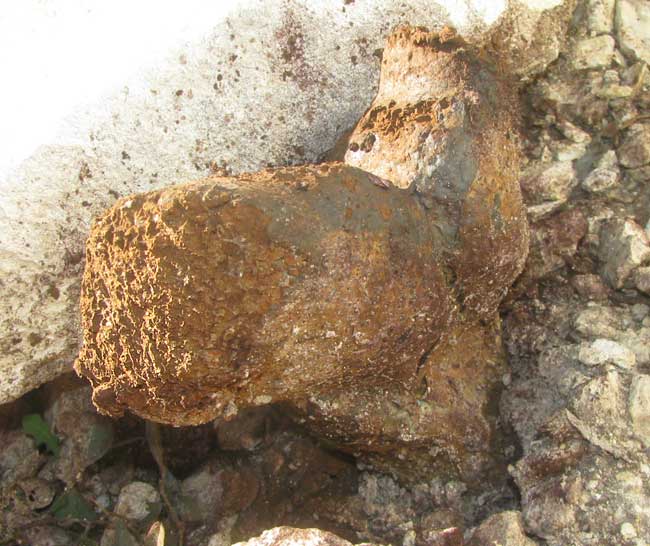Excerpts from Jim Conrad's
Naturalist Newsletter

from the December 1, 2013 Newsletter issued from the Frio Canyon Nature Education Center in the valley of the Dry Frio River in northern Uvalde County, southwestern Texas, on the southern border of the Edwards Plateau; elevation ~1750m (~5750 ft); N29.62°, W99.86°; USA
DYEMAKER'S PUFFBALL
Right beside Juniper House's kitchen steps an odd-shaped, four-inch-high (10cm), rusty-brown, fairly ugly heap of something turned up in very disturbed gravel and dirt where this summer I'd piled shattered rock pick-axed from the septic tank I was digging. Later I'd wheelbarrowed away the rocks, but the ground had remained hard-packed and rocky. The thing heaped there now looked like a dog turd, except it had a hint of a stem and was halfway forked. That's it above.
Surely it was a fungal puffball, though I'd never seen a puffball like this. I think of a normal puffball as ball-like with powdery spores escaping in dusty puffs. If this one is shedding spores, apparently it does so by simply breaking up like a hunk of crumbly cornbread.
After browsing hundreds of pictures of Texas puffballs I hadn't found anything like it. However, eventually I figured it out -- by accidentally stumbling upon a picture of one like it as I tried to identify yet another weird fungus, considered in the next section. This week's rains have caused lots of mushrooms to pop up.
Usually our kitchen-step fungus is called Dyemaker's Puffball, though mushroom guru Tom Volk at the University of Wisconsin unabashedly refers to it as the Dog Turd Fungus, and in Australia it's the Horse Dung Fungus, and in Europe a name is Bohemian Truffle, probably used to gleefully deprecate Bohemians.
It's PISOLITHUS TINCTORIUS, a member of the seldom-heard-of Hard-skinned Puffball Family, the Sclerodermataceae, a widespread family in both temperate and tropical regions embracing species that most people don't notice or think of. The more familiar puffballs most of us know belong to different families. Our Dyemaker's Puffball occurs nearly worldwide.
The genus name Pisolithus literally means "pea stone," and in this case the fungus's peas are pea-shaped, pea-sized reproductive structures called "periodioles," which are scattered throughout the fungus's interior in a black gelatinous matrix. The mushroom matures from the top down, so in our picture the top periodioles already have matured and they and their matrix have dried into a soft, spongy, rusty-brown, spore-filled "gleba." And, it's true: Its spores haphazardly disseminate as the fungal body degenerates from the top down, some carried away by wind, others washed downslope by rainwater, or maybe by being stumbled into, broken and scattered by deer.
The name Dyemaker's Puffball comes about because the mushroom in its immature state, when its periodioles still are suspended in blackish, gelatinous matrix, a dye can be extracted from the mushroom that imparts a reddish brown to blackish hue to wool.
The most important and useful feature of the Dyemaker's Puffball, however, is that it's a mycorrhizal fungus. That means that it acquires its nutrition in a mutualistic (mutually helpful) association with the roots of trees. If you need to brush up on what mycorrhiza is, we have a dandy page all about it at https://www.backyardnature.net/f/mycorhza.htm.
Dyemaker's Puffballs form mycorrhizal associations mainly with conifers and oaks. Ours was near a Texas Liveoak, so probably it was helping out that pretty tree.
In fact, Tom Volk calls Dyemaker's Puffball a "super-mycorrhiza" because it forms associations with many different plant species, and thrives in a broad range of soil types, especially disturbed and even polluted ones, such at those of old stripmines. Often mycorrhizal fungi associate with only a single or a very few tree species. Dyemaker's Puffball's spores are sold commercially as an "inoculum" for coating seeds of plants to be sowed. Plant's sprouting from seeds inoculated with Dyemaker's Puffball spores often are more robust and able to survive severe weather and soil conditions better than plants from uninoculated seeds.
You can buy a 1½ pound (680g) bag of "mycorrhizal landscape inoculant" containing the spores of Dyemaker's Puffball (listed as Pisolithus tinctorius) and eight other fungus species for $52.50 at http://www.bio-organics.com/product/mycorrhizal-landscape-inoculant/.
In that purchase you are guaranteed to receive 45,000,000 spores in each 1.5lb container.